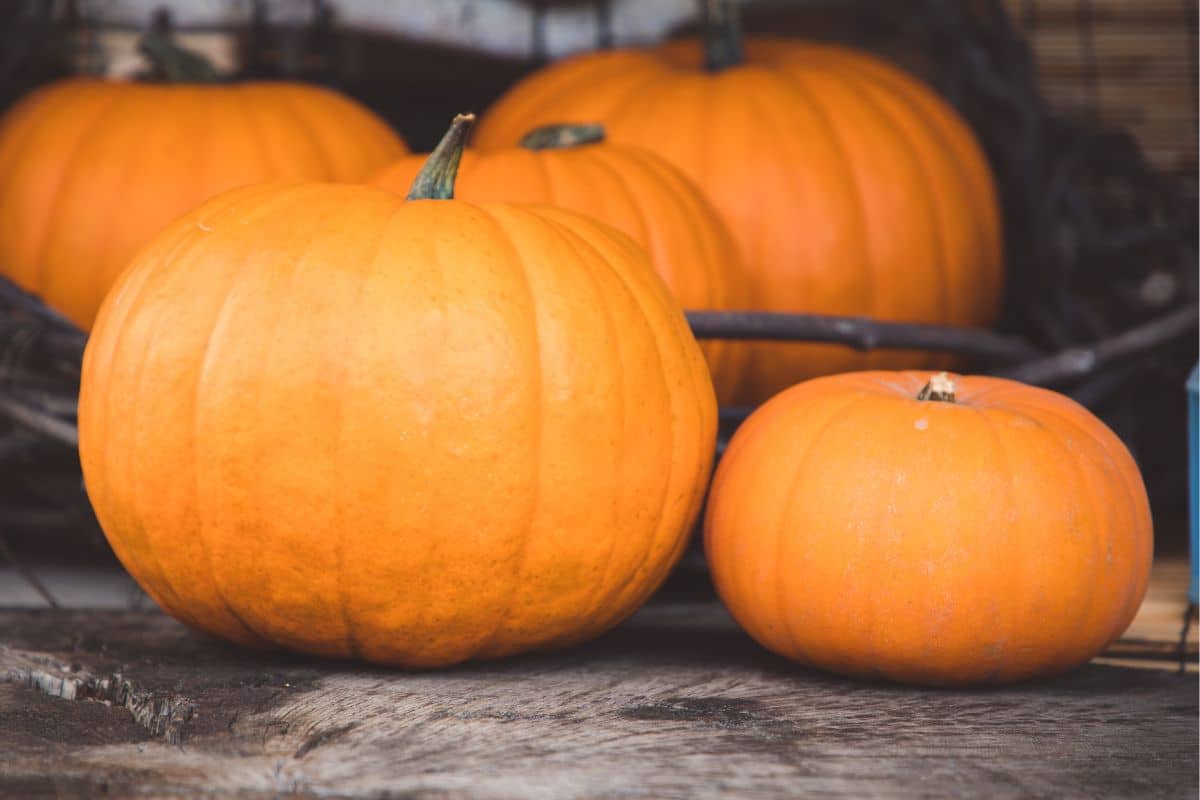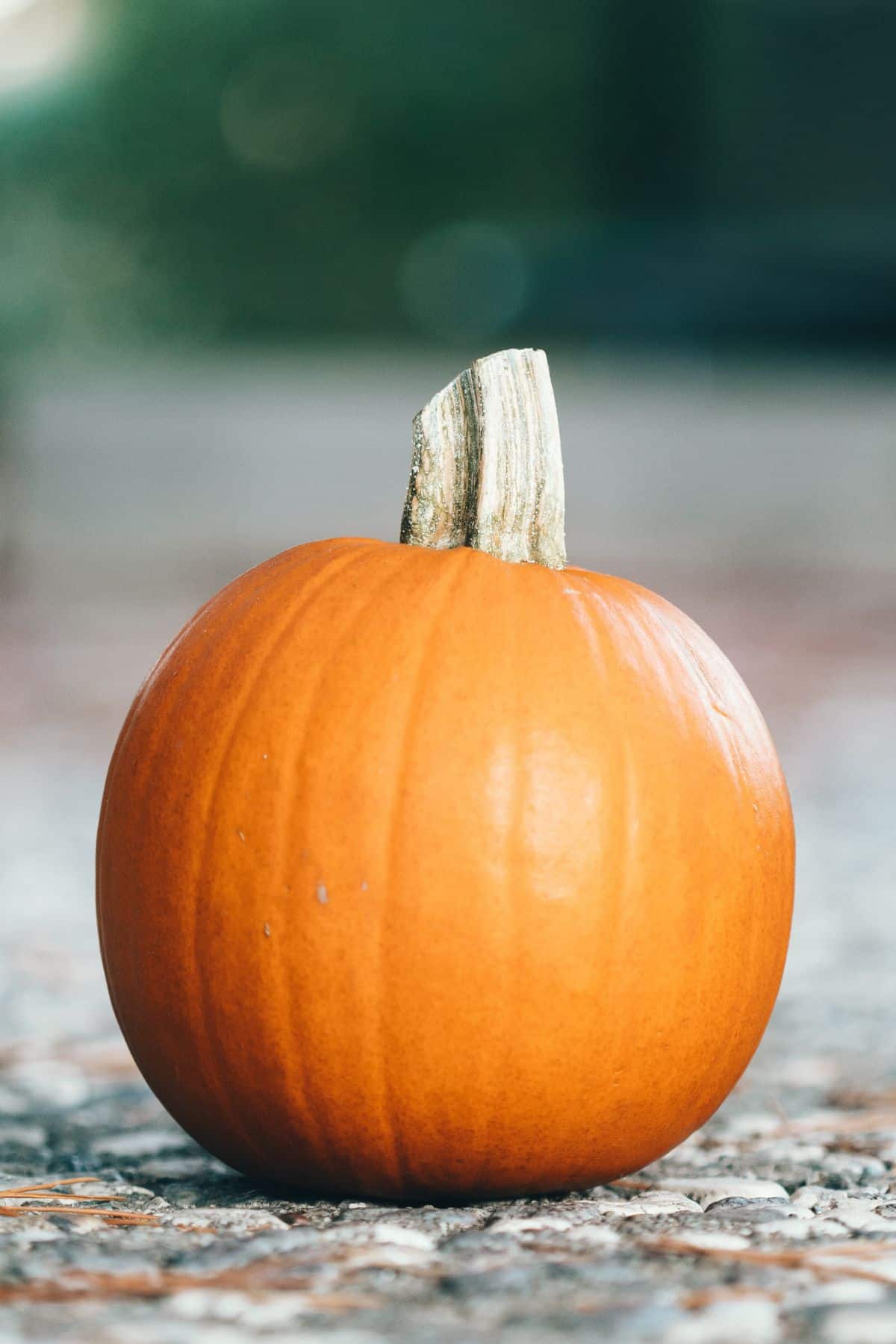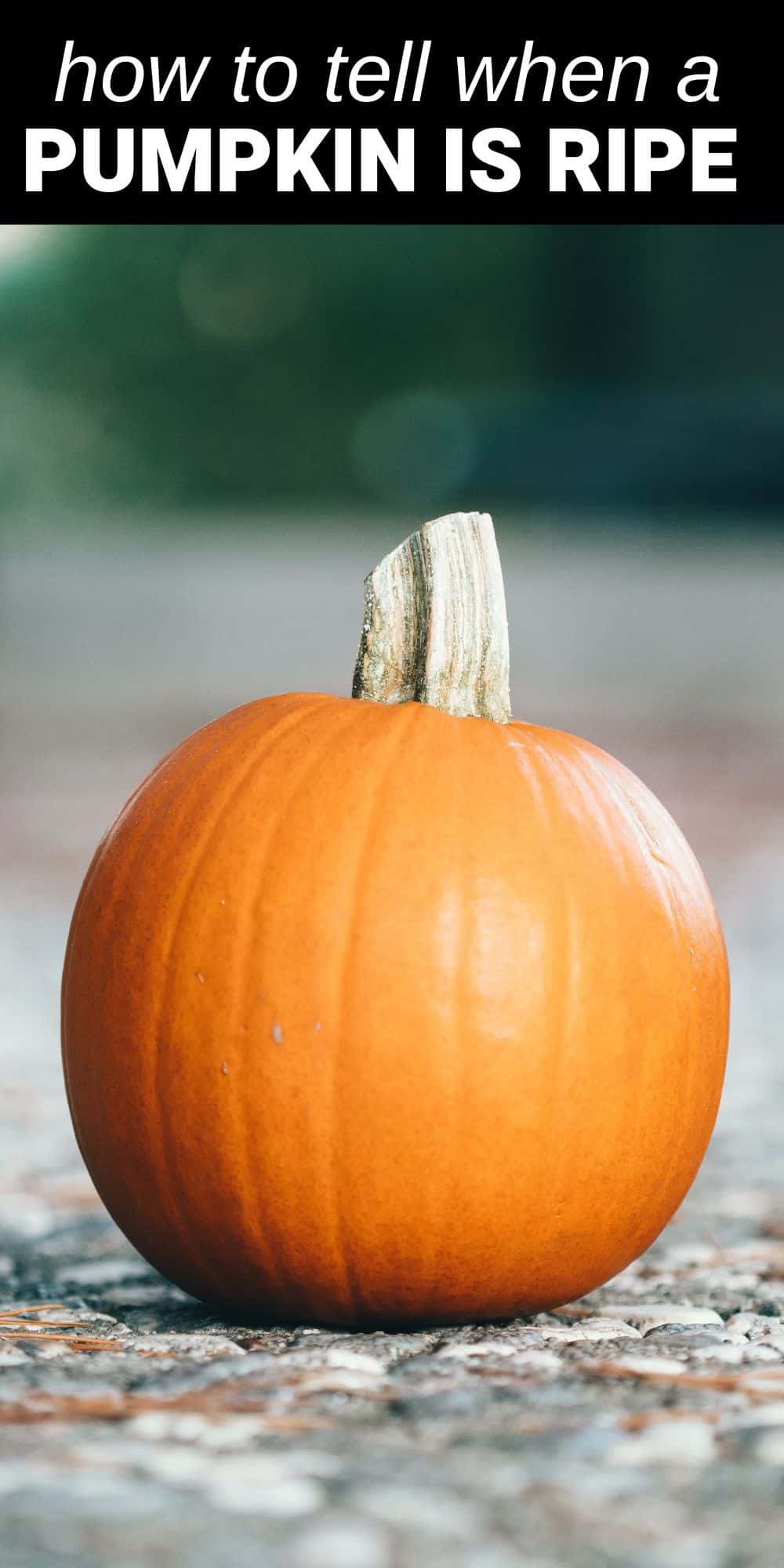From desserts to decor, pumpkins are everywhere in the fall and we’ve got all the tips and tricks to help you pick the perfect one. Whether you prefer to grow your own pumpkins or pick one from the farmer’s market, pumpkin patch, or grocery store, it’s important that they’re harvested when perfectly ripe. This allows them to have a longer shelf life, make them less likely to rot, and ensure they have the best flavor for all those delicious pumpkin recipes. Read on for our best ways to tell when a pumpkin is ripe.

Table of Contents
5 Signs a Pumpkin is Ripe
- It’s the Right Time of Year
- Your Fingernail Doesn’t Puncture the Rind
- You Knock on the Rind and Hear a Hollow Sound
- The Stem Begins to Turn Brown
The Color: The Gourd Turns the Desired Color
One of the easiest ways to tell if a pumpkin is ripe is to check the color. The pumpkin should reach its mature color and be an even shade all over. Most varieties of pumpkin will ripen from a green to a deep orange color. However, it’s worth noting that some varieties of pumpkin are white, yellow, or even green when fully mature, so it’s good to be familiar with the pumpkin variety and know what the desired color should be.
The Stem

The stem of a ripe pumpkin should be dried out and starting to turn brown. This is a sign that the vine is starting to die and isn’t delivering as many nutrients to the pumpkin. If you’re harvesting your own pumpkins from your garden, you shouldn’t pick them before this point, and it’s actually okay to let the entire vine die before you harvest it. If selecting a pumpkin from the store, avoid any that have a stem that is still green and spongy, as this is a sign that it has been picked too soon.
The Skin
The skin of the pumpkin should be firm and smooth with no signs of wrinkles when it’s ripe. You can test the firmness of the skin with the fingernail test. Try to puncture it with your fingernail, and if it’s soft enough that you can make an indentation, it’s an indication that the pumpkin is overripe and likely to shrivel soon. Another good indicator is a matte finish as opposed to shiny skin. Most varieties of pumpkin will lose some of their sheen as they ripen.
The Sound
Did you know that a ripe pumpkin makes a particular sound when you knock on the rind? It sounds strange, but it’s true! If your pumpkin is the proper color and the pumpkin’s stem is properly dried out, the thump test is one more way to determine if your pumpkin is perfectly ripe. Give the rind a knock, and see if you hear a hollow thump. This hollow sound is a good sign that your pumpkin is ripe, whereas unripe pumpkins will make more of a solid knock.
Learn the difference between pumpkin puree and pumpkin pie filling for recipes.
Days Until Maturity
The best time to harvest most pumpkins is in the fall, typically in late September or October, but this also depends on the pumpkin variety and when they were planted. As a general rule, your pumpkins will be able to survive a light frost, but should be harvested before the first hard frost of the season and before night temperatures get into the 20s.
The seed packet or plant label may have harvesting guidelines and will often tell you the approximate number of days from planting to maturity. You can use these as a guide, along with the other tips to determine ripeness.
How to Harvest Pumpkins
When it’s pumpkin harvest time and you’ve determined that your pumpkin is ready to pick, the first thing you’ll want to do is get a clean, sharp knife. Then simply cut, leaving about 4 inches of stem. When transporting your pumpkin, be sure to carry it from the bottom and not the stem. Also, be gentle with your pumpkins and try to avoid bumping and bruising them. It’s important that the pumpkin stem stays intact and does not break off, as this will make your pumpkin more prone to rotting, as will bruises and other damage to the outer skin.
After harvesting the pumpkins, it’s a good idea to cure them to help to harden their skins and heal any scratches or cuts. You’ll want to cure them at a temperature of 80 to 85 degrees Fahrenheit and 80 percent relative humidity for 10 days. After the curing process, store pumpkins in a cool dry place until you’re ready to use them.
Best Varieties of Pumpkins
There are hundreds of different types of pumpkins, from mini to giant, in shades of orange, yellow, and white. There are even some varieties of green and black pumpkins. Some are best for decorating or carving for Halloween, while others are ideal for making delicious pumpkin pies and other fall goodies.
- For Eating – If you’re planning to make a favorite fall soup or some delicious pumpkin treats, look for sugar pumpkins, which are also sometimes called sweet pumpkins or pie pumpkins. These are smaller pumpkins with a round shape, a deep orange color, and a naturally sweet flavor that makes them perfect for baked goods. (And don’t forget to roast the pumpkin seeds for a healthy and delicious snack!) One small pumpkin will generally yield about 2.5 cups of fresh pumpkin puree, which should be more than enough for a pie.
- For Carving – Looking for a pumpkin to carve for Halloween? You’re probably looking for a Howden Field Pumpkin. These vibrant orange pumpkins are the classic Jack-o-lantern pumpkins. They’re a medium-sized variety that’s uniformly tall and wide, making them a great choice for carving.
- For Decorating – Finally, if you’re looking for some eye-catching varieties for your fall decor, check out the Warty Goblin. It’s covered in creepy-looking green spots for a fun and spooky look. The dark knight is a black variety of pumpkin which is also a fun and unique choice. And the ghostly white pumpkin variety called the Casper is always a fun choice as well.
Whether you’re picking them from the pumpkin vines or picking them out at the farmer’s market or grocery store, I hope you feel confident in your ability to identify a perfectly ripe pumpkin. Use these great tips and grab your fall pumpkins, then start baking, carving, and decorating like a pro.
Can I Pick Pumpkins Early?
It’s not recommended to pick pumpkins early as the pumpkin isn’t fully ripe and ready to harvest.
What Month are Pumpkins Ready to Pick?
Another common question, Is September too early to pick pumpkins? Pumpkins are ready to pick usually in the fall months. The exact month can vary depending on the specific variety of pumpkin you are growing and your local climate, but pumpkins are usually ready for harvest from late September through October..
What Happens If you Pick a Pumpkin Too Soon?
Picking a pumpkin too soon can have several negative consequences, as pumpkins continue to develop and ripen on the vine until they are fully mature. Here are some potential issues that can arise if you pick a pumpkin prematurely:
- Underdeveloped Flavor: Immature pumpkins often lack the full flavor and sweetness that develops as they ripen on the vine. This can result in a less enjoyable taste when you use the pumpkin in recipes or for carving.
- Poor Texture: Young pumpkins may have a softer and less desirable texture compared to fully mature ones. They might be more watery and less firm, making them less suitable for certain culinary applications.
- Reduced Shelf Life: Pumpkins picked too early are more susceptible to rot and decay, as their skin and flesh may not be fully developed to resist pests and diseases. This can lead to a shorter shelf life and spoilage.
- Smaller Size: Pumpkins continue to grow as they mature on the vine. Picking them too soon can result in smaller pumpkins than if you had allowed them to reach their full size potential.
- Less Vibrant Color: Immature pumpkins may have a duller color compared to ripe ones. They might not achieve the vibrant orange or other color characteristic of their variety.
- Difficulty Carving: If you plan to carve your pumpkin for Halloween or decorative purposes, a premature pumpkin might be harder to work with. It may have softer, less dense flesh, which can make carving and shaping more challenging.
To avoid these issues, it’s best to wait until your pumpkin is fully mature before harvesting it. The specific timing can vary depending on the pumpkin variety and growing conditions, but a general rule of thumb is to wait until the pumpkin’s skin is hard, the color is uniform, and the stem starts to dry out. This ensures that you get the best flavor, texture, and longevity from your pumpkin.








Leave a Review!